
Guests
- Kaniela Ingformer member of the Hawaii House of Representatives representing Maui, currently national director of the Green New Deal Network.
We speak with Kaniela Ing, national director of the Green New Deal Network and seventh-generation Kanaka Maoli, Native Hawaiian, about the impact of this week’s devastating wildfires and their relationship to climate change. The catastrophic fires have destroyed nearly all buildings in the historic section of Lahaina, which once served as the capital of the Hawaiian Kingdom. What is now being described as the worst natural disaster in Hawaii’s history was created by conditions such as dry vegetation, hurricane-level winds and developers redirecting water and building over wetlands, which are directly related to the climate crisis. “Anyone in power who denies climate change, to me, are the arsonists here,” says Ing. “We’re living the climate emergency.”
Transcript
AMY GOODMAN: This is Democracy Now!, democracynow.org. I’m Amy Goodman.
We continue to look at the catastrophic wildfires in Maui. We turn to Kaniela Ing, who is the national director of the Green New Deal Network. Ing is a seventh-generation Native Hawaiian from Maui. I spoke to him on Thursday night, asking him to talk about what’s happened to Maui and the historical significance of Lahaina Town.
KANIELA ING: Sure. First off, thank you for having me and centering this issue. I will preface by saying that I’ve been really busy, but when I’m not doing these interviews, I just tend to, like, break down. These are really somber times. I was born and raised in Maui. I’m Kānaka Maoli, Native Hawaiian, come from seven generations. And our island is on fire. Our most historic town was set ablaze by wildfires. Hundreds of people have been evacuated and hospitalized. The death toll is climbing, and people are searching for loved ones right now.
So, Donald Trump, Ron DeSantis, Tim Scott, Joe Manchin, oil companies and anyone in power who denies climate change, to me, are the arsonists here. And we’re living the climate emergency.
So, it is sad times right now. It’s heartening to see the community come together and, you know, deliver goods to the families in need. Fundraising has been incredible for the direct relief. But what I am wondering, personally, is, once the recovery efforts start to unfold and the cameras are gone, who’s going to be left more powerful or less powerful? Are people still going to be paying attention when the recovery work is going to last for years? And is that going to make community members stronger, or is it going to make the people who have mismanaged the land and water and created the conditions for these fires to happen even more powerful? And that’s what we’re focused on at Green New Deal Network right now.
AMY GOODMAN: Kaniela, can you talk about specifically the friends, the family, what has happened to those that have been devastated by the fires, particularly in Lahaina? Can you tell us some of those escape stories, some of what has taken place with the fires so suddenly wiping out this historic city? And then talk about the historic nature of Lahaina as the capital of the Hawaiian Kingdom and what that means.
KANIELA ING: We’re a tropical island here on Maui. We’re not supposed to have wildfires. This came as a shock to everyone. There’s not enough firefighters here. We can’t ship them over from the next state. We’re an island. So, everyone right now is feeling a bit overwhelmed. As it occurred, we saw community members jumping into the ocean with nowhere else to go, just floating and watching their homes being reduced into ashes. The death toll went from six to 36 all of a sudden, and there are still firefighters, Red Cross members out there searching for our loved ones. It was — it was apocalyptic. The scene was something that, you know, you would only see in a movie. But the reality is, like, this is becoming quite the norm now, and it will become more so in the future.
Lahaina Town is actually — it’s often characterized as a tourist town, but the people who live there — which should be the focus — tend to be some of the most rooted Native Hawaiians that I’ve ever met. They’re the types of — their families, from generations ago, created aquaculture, which, like, the West is only kind of learning about now. You know, I used to work with them to, like, figure out better ways that NOAA could manage, like, fisheries. They’re really the keepers of the ancestral knowledge. And, you know, some of their — yeah, like, most of the folks that evacuated are, like, Kānaka Maoli or other immigrant folks. And my heart goes out to those families.
AMY GOODMAN: When you say it’s a tourist town, that’s because it’s historic. So, talk about what that means. Give us a history lesson about Hawaii and about Maui, and how it relates to the mainland United States, even how it became a part of the United States.
KANIELA ING: Sure. So, Lahaina Town was a thriving center of Hawaii. It was like the heart of Hawaii before not just statehood, but before Hawaii was even a territory of the United States. So, if you start from one end of Front Street and walk to the other, it’s like a Disneyland ride through the colonial timeline of capitalism in Hawaii, starting from royalty, going to whaling, sandalwood, sugar and pineapple, tourism to luxury.
And to me, the fire is a tragic symbol of this trajectory’s terminal point, like where it all ends up if you continue down this mode of extraction as a way to live. But it’s also like the — it also contains the most deep and durable relics of our history of resistance: the museums, the architecture, the infrastructure, the banyan tree — the oldest and largest in the United States, which has burned, 150 years old this year. Like, it includes all that, but also just the fact of how slow it was to develop is a testament to the people-powered, usually Native-led resistance that each industry faced along the way.
AMY GOODMAN: You refer to the raging wildfires as a result of colonial greed. Explain.
KANIELA ING: Yeah. So there’s two facets to this. First is climate change. The National Weather Service says the cause of this fire was a downed power line, and the spread because of hurricane-force winds. And the spread was caused by dry vegetation and low humidity. Those are all functions of climate change. This isn’t disputable. This isn’t political. It, unfortunately, has become politicized, but it’s a matter of fact. Climate pollution, corporate polluters that set a blanket of pollution in the air that is overheating our planet contributed — caused the conditions that led to this fire.
In addition, there is mismanagement of land. The original “Big Five” oligarchy in Hawaii, missionary families that took over our economy and government, they continue on today as some of our largest political donors and landowners and corporations. They’ve been grabbing land and diverting water away from this area for a very long time now, for generations. And Lahaina was actually a wetland. You could take a — like, Waiola Church, you could have boats circulating the church back in the day. But, you know, because they needed water for their corporate ventures, like golf courses and hotels and monocropping, that has ended. So the natural form of Lahaina would have never caught on fire. These disasters are anything but natural.
So, yes, colonial greed and the fact that they caused the pollution that warmed our planet and set hurricanes like this to become the norm, and the gross mismanagement of our land and water, which the Green New Deal actually is about returning both — you know, both mitigating climate change, building resilience, but also returning the stewardship of land and water to the people.
AMY GOODMAN: Can you talk about the dry land right now? I mean, you have Hurricane Dora hundreds of miles away. The wind was intense, but the drought that existed, that relationship to climate change?
KANIELA ING: Yeah, that’s right. So, growing up on this island, we saw maybe one or two fires, and they were very contained, when things got to this drought factor. It’s never been anything close to this. This shocked even — even like the climate scientists that I’ve worked with over the years were shocked by this fire.
And a lot of it has to do with these dry conditions. Growing up, my dad would drive us to church, and he would point out to the sugarcane, and he’d say, “When you’re my age, all this sugarcane will be gone.” And I was like, you know, “OK, sure.” It’s such a central part of Maui. But he was right. The sugar is gone. And the reason why is because one of these Big Five oligarchical corporations that I spoke of knew that the sugar wasn’t profitable, but they continued monocropping most of the island in order to get some tax breaks for agriculture.
Now, I grew up in a community where it would rain cane ash on us, and it was like fun. I didn’t realize we were all getting asthma. It’s an environmental justice community. But, you know, there were people that fought against the cane burning. And the corporation ended up blaming the activists for the sugar shutting down, pitting the union workers against the community. The result now is just like a fallow, really dry land across the whole central valley of our island. And really, if community members and union members were to unite and had been organized years ago, we could have had a much different future. And that’s still something that I think we should continue working to build, is that labor and environmental unity.
AMY GOODMAN: Can you talk about the April survey of homeless people, unhoused people? I think it was something like 704 unhoused people in Maui County, among them 244 suffering from mental health disabilities. The unhoused crisis among Native Americans, Native Hawaiians, and what do you know about Native Hawaiians who were unhoused and how the wildfires have affected them?
KANIELA ING: Yeah. I think there’s a certain perception of Native Hawaiians who are unsheltered that’s not — that does not fit with reality. Some of the unsheltered Hawaiian communities that continue today were occupations of land that was getting seized. And they were like, “Look, we don’t want to cooperate with this, with this new extractive economy that y’all created, so we’re going to live by ourselves in our own community on this beach. We’re going to govern ourselves.” And they’re quite organized, and they’re living in a way that’s subsistent and in harmony with nature. Now, it’s not to be glamorized. A lot of these folks face some really dire conditions not being a part of this capitalist system. But a lot of them are doing it based on really strong and sensible beliefs.
Now, when a climate crisis hits, when a disaster hits, it’s going to impact these people first and worst, no doubt. And we need to make sure that both relief and recovery efforts, in the longer term, are prioritizing the low-income and Indigenous people that are some — some are still unaccounted for. Some don’t even have IDs. And, you know, they need to be front of mind with everything we do, from, you know, day zero, when the disaster breaks, to years out, when we’re recovering.
AMY GOODMAN: The wildfires occurred on the same day that President Biden said in an interview that he had “practically” declared a climate emergency, but he has not actually formally done that. What would that mean?
KANIELA ING: Yeah. I’ve just been frantically trying to make sure that my loved ones are OK. But I also work on climate. This is my job. And as soon as I start thinking about that statement from President Biden, I just get so incensed. This is a climate emergency. There’s no practical — “practically” he declared it. You either believe it or not. And I think as bad as Republicans have been by denying climate, Democrats are just as culpable by not doing enough. Scientists say that we need to be investing at least $1 trillion a year in the clean energy transition. We need to end and phase out, deny all new fossil fuel permits, and really empower the communities that build back ourselves democratically. That’s the solution for it.
And President Biden announced his second term, but he hasn’t told us how he’s going to finish the job. He needs to lay out that vision, what we’ve been demanding from a Green New Deal, if he wants communities that got him elected to come out, that base of climate voters, that happen to be predominantly Black, Indigenous and low-income people. But we need something forward-looking to come out, because right now, like, I’m not even thinking about voting, right? Like, nobody in Lahaina is thinking about whether or not they support Biden. Like, give us something. You know, at least let us be seen.
So, you know, I think that’s that sense of urgency. Even me, who is in this climate work full time and see these events unfold elsewhere, until it hits you at home and it’s people you know, grocery stores you shop at, schools your kids go to, your church actually being burned down, you’re not going to understand the urgency. Like, it is shocking. And we’re not talking 10 years from now. We’re having — these things are happening right now. It could happen to your home tomorrow. That’s the urgency we’re dealing with, and we need to act accordingly. So, no “practically” speaking. Like, we need to move now and do everything we can.
AMY GOODMAN: And can you tell us more about the importance of Indigenous wisdom and practices in addressing the climate catastrophe?
KANIELA ING: Sure, yeah. So, going into Lahaina, the people that actually lived there for generations are the keepers of some of the most profound Indigenous knowledge that I have ever met. They understood subsistence fishery, how native plants were buffers against, like, you know, disasters, how to create regenerative agricultural practices. And it’s that view of the world where, you know, our success isn’t determined by how much we hoard, but rather how much we produce for others and share, and where, like, our economy is not based on how well the rich are doing, but how many people, how many of us, can actually thrive. Like, it’s that — it’s not just Indigenous knowledge, but it’s that value system that really needs to be reestablished.
So, you know, I think over the years, especially in my line of work, there’s been more resources for Indigenous folks to lead frontline fights against bad projects. But the intervention that really needs to happen is Indigenous leaders also need to be resourced to build the good. They need to be the purveyors of and architects of the new green and, like, community-rooted world that’s still possible, even in these dire times.
AMY GOODMAN: Finally, would you like to leave us with some images that you have been living through over these last few days, like the banyan tree, where you show us — when you put out on social media the before and after the wildfires, but other images or stories of people’s bravery in trying to preserve what you have known for so long?
KANIELA ING: Yeah, I mean, as we’re speaking, there’s people that still haven’t found their loved ones. A lot of the friends I grew up with — like, I come from a lower-income neighborhood — they’re firefighters. I ran into one on the way here, and I’m just like, “Hey, y’all are doing a great job.” And he was just sweating and, like, started crying and, you know, barely — looked like he hasn’t slept in days.
Hotels are letting residents in, without cost, to sleep. Multiple businesses are just letting people drop off goods, and they’re shipping it three to four times a day. They’re leaving their doors open 24 hours. So, there is that sense of, you know, this is an island; we’re all in this together. And that sense of mutual aid and solidarity is really carrying us through, and it’s been quite remarkable to witness. But, you know, don’t want to leave you with some toxic positivity either. Like, these are hard times, and unless we take urgent action now, it’ll only get worse.
AMY GOODMAN: And what, do you feel, is the most important thing that President Biden, the federal government, people should be pushing for right now?
KANIELA ING: Well, right now we need direct aid. But there needs to be a longer focus on recovery, that these — that we can’t rebuild the community in a few weeks. It’s going to take years. And we need to do it intentionally, not just making sure — not just bringing us back to the status quo, because the status quo is what led us here, but making sure that we have more democratic and community-controlled institutions that come out of this.
Unfortunately, the groups that are best poised to deploy direct aid, because of their institutional connections, are also the most likely to enable disaster capitalists from exploiting the situation. So, we need to create — we need to understand that, you know, as we’re, like, trying — as people want to help, that they’re resourcing groups that have an eye towards community organizations, to the organizers that will actually be there once the cameras leave, and will be rebuilding from the ground up over the course of the long run.
AMY GOODMAN: And one more time, can you tell us why the banyan tree is so important?
KANIELA ING: Yeah. I mean, the banyan tree is so iconic. There’s like 16 trunks. It’s the largest in the United States. It just turned 150 years old in April. And the images of it being completely toasted is heartbreaking. Now, I have hope, because trees have deep roots, especially of that age, that it will continue on. And, you know, that’s the vision in my mind, right? Like, as we rebuild as a community, as we realize the vision of a Green New Deal nationally and globally, the banyan tree also regrows its leaves and is a positive symbol for what’s to come.
AMY GOODMAN: Kaniela Ing, the national director of the Green New Deal Network, seventh-generation Native Hawaiian, speaking to us from Maui. And I especially thank my little pup Zazu for staying quiet during that interview, which makes me think about all of the fauna and the flora destroyed, as well, on Maui and, of course, most importantly, the people.
Coming up, we speak to another Native Hawaiian activist and a fire scientist at the University of Hawaii. Back in 20 seconds.
[break]
AMY GOODMAN: “Sugar Man” by Rodriguez. Sixto Rodriguez, the subject of the 2012 Oscar-winning documentary Searching for Sugar Man, passed away this week at the age of 81 in his home in Detroit.

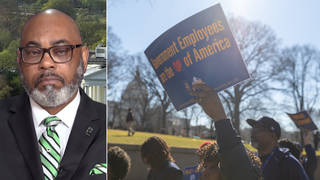
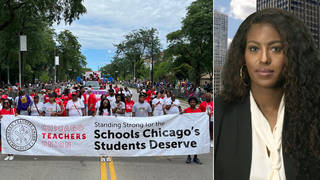
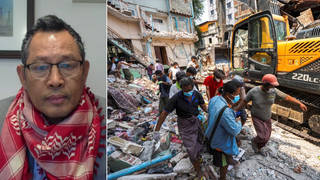
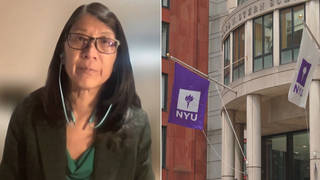





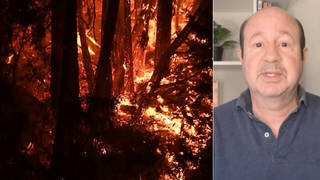
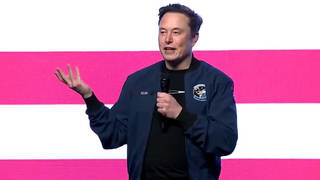
Media Options